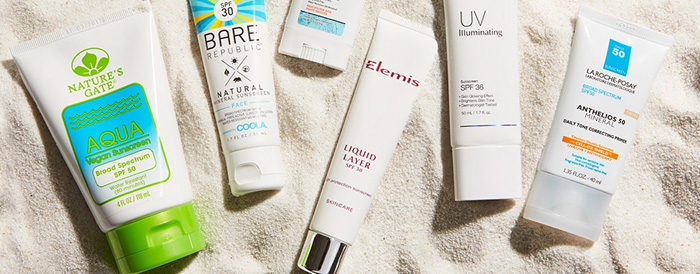
Check the expiration date on your sunscreen before you bring it to the beach
Sunscreens don’t last forever.
Active ingredients, whether chemical or mineral, become less effective as they age.
The Food and Drug Administration requires sunscreens to display an expiration date matching what testing shows. If there isn’t a date, the product should be considered expired after three years.
Summer is here again, and that means digging swimsuits and beach towels out of the closet. Before you toss old sunscreen in your bag, check the expiration date.
Sunscreens don’t last forever. Chemical formulas are made with active ingredients like oxybenzone that become less stable, and therefore less effective, as they age. Mineral versions that are made with zinc oxide and titanium dioxide also lose their ability to protect you as they get older.
The Food and Drug Administration regulates sunscreen as over-the-counter drugs because they make claims to help prevent sunburn or to decrease the risks of skin cancer and early aging caused by the sun. It requires them to display an expiration date matching what testing shows. If there isn’t a date, the product should be considered expired after three years.
Using old sunscreen isn’t necessarily harmful on its own, but it won’t work as well — and you probably already aren’t getting as much protection as you think you are, said Dr. Dawn Davis, a dermatologist at the Mayo Clinic.
A 2002 study found most people only use 25 to 50 percent the recommended amount. The American Academy of Dermatology suggests using one ounce to cover your whole body, or enough to fill a shot glass.
“If your SPF is 15 and you’re only using one-third of the amount you’re supposed to, you’re getting SPF 5,” Davis said. “If (sunscreen is) expired, the chemicals won’t be as powerful at doing their job, which means you’re lowering the sunscreen potential.”
Expiration dates on Johnson & Johnson’s sunscreens are two years from the time the products are made, though well-made products should have a shelf life of between two and three years, said Menas Kizoulis, scientific engagement director of beauty. J&J’s Neutrogena brand captures 23 percent of the $1.6 billion U.S. sun protection market, according to market research firm Euromonitor.
Edgewell Personal Care, which makes Banana Boat and Hawaiian Tropic sunscreens, said in a statement to CNBC that on average, its SPF products are effective for three years after the date they were manufactured. Bayer’s Coppertone sunscreens have shelf lives of either two or three years, depending on the formula, said Henri Marion, Bayer’s technical category lead of sun care.
While expiration dates are good guide, they’re not always perfect because sunscreens can age quicker depending on how you store them. Extreme temperatures and excessive moisture can cause those active ingredients to break down faster, Kizoulis said. So if you left your sunscreen sitting on the dashboard of your car all last summer, it might not be as effective this year.
There are signs of aging you can look for. If an oily liquid flows separate from the solid when you squeeze a tube of lotion, that means the integrity of the formulation has been compromised and you won’t get the SPF the label promises, so you should throw it away, said Kizoulis.
Sprays and sticks can be trickier to check. If they don’t look the right color, that’s a sign they’re ready for the trash. They hold up better than lotions, he said. Sprays tend to be packaged in more robust containers, and sticks aren’t usually made with water.
“(All forms of sunscreen) have their pros and cons,” he said. “Generally, all the options are great choices.”
Chemical sunscreens work by absorbing the ultraviolet light rays that are hitting the skin and transforming it into heat. Mineral formulas do the same, but they also deflect the rays.
Whether chemical or mineral or lotion or spray, finding a sunscreen you like and using it is important. Sun damage increases your risk of contracting skin cancer over time, Davis said. The most common form of cancer in the U.S., 76,665 people were diagnosed with melanomas of the skin in 2014, according to data from the Centers for Disease Control and Prevention.
Sun damage can also make your skin age and wrinkle. Just one-third of American adults said they usually or always apply sunscreen with an SPF of 15 or higher, according to CDC survey data.
Yet more people are focused on prevention these days, helping boost the sun protection category, said Kayla Villena, a senior analyst at market research firm Euromonitor International.
People are wearing it daily instead of just at the beach, she said. Companies are responding to the demand with new formulas that are lighter and more comfortable to wear all day. That requires art, J&J’s Kizoulis said.
“Just getting a sunscreen that say we’re making an SPF 30, that’s not rocket science,” he said. “We can combine sunscreen filtering ingredients with some moisturizing ingredients to create a sunscreen formulation.”
“The real art is how do you develop a product that has specific characteristics, such as being really light and doesn’t have a greasy feel,” he said. “By nature, sunscreen ingredients themselves have an oily feeling we’re always trying to overcome.”
Once you pick a sunscreen you like, make sure it’s not expired, you’re using enough of it and you’re reapplying often.
“If (consumers) have sun care products from the year before, it’s probably an indication they haven’t used enough,” Bayer’s Marion said. “It’s about protection and reapplication. So generally one bottle from last summer for an entire family means you’re definitely not using enough.”
Source: NBC

